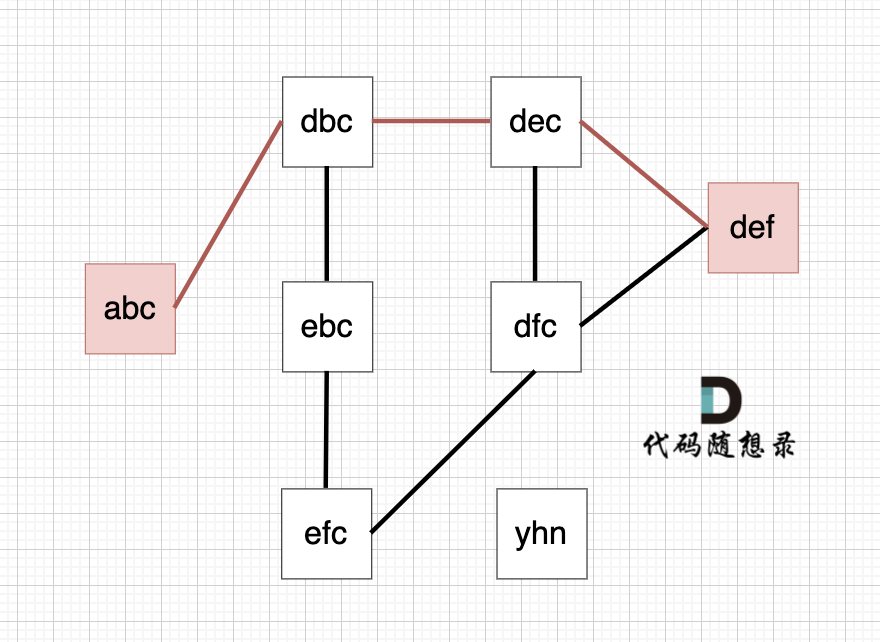参与本项目,贡献其他语言版本的代码,拥抱开源,让更多学习算法的小伙伴们受益!
题目描述
字典 strList 中从字符串 beginStr 和 endStr 的转换序列是一个按下述规格形成的序列:
-
序列中第一个字符串是 beginStr。
-
序列中最后一个字符串是 endStr。
-
每次转换只能改变一个字符。
-
转换过程中的中间字符串必须是字典 strList 中的字符串。
给你两个字符串 beginStr 和 endStr 和一个字典 strList,找到从 beginStr 到 endStr 的最短转换序列中的字符串数目。如果不存在这样的转换序列,返回 0。
输入描述
第一行包含一个整数 N,表示字典 strList 中的字符串数量。 第二行包含两个字符串,用空格隔开,分别代表 beginStr 和 endStr。 后续 N 行,每行一个字符串,代表 strList 中的字符串。
输出描述
输出一个整数,代表从 beginStr 转换到 endStr 需要的最短转换序列中的字符串数量。如果不存在这样的转换序列,则输出 0。
输入示例
6
abc def
efc
dbc
ebc
dec
dfc
yhn
输出示例
4
提示信息
从 startStr 到 endStr,在 strList 中最短的路径为 abc -> dbc -> dec -> def,所以输出结果为 4
数据范围:
2 <= N <= 500
以示例1为例,从这个图中可以看出 abc 到 def的路线 不止一条,但最短的一条路径上是4个节点。
本题只需要求出最短路径的长度就可以了,不用找出具体路径。
所以这道题要解决两个问题:
- 图中的线是如何连在一起的
- 起点和终点的最短路径长度
首先题目中并没有给出点与点之间的连线,而是要我们自己去连,条件是字符只能差一个。
所以判断点与点之间的关系,需要判断是不是差一个字符,如果差一个字符,那就是有链接。
然后就是求起点和终点的最短路径长度,这里无向图求最短路,广搜最为合适,广搜只要搜到了终点,那么一定是最短的路径。因为广搜就是以起点中心向四周扩散的搜索。
本题如果用深搜,会比较麻烦,要在到达终点的不同路径中选则一条最短路。 而广搜只要达到终点,一定是最短路。
另外需要有一个注意点:
- 本题是一个无向图,需要用标记位,标记着节点是否走过,否则就会死循环!
- 使用set来检查字符串是否出现在字符串集合里更快一些
C++代码如下:(详细注释)
#include <iostream>
#include <vector>
#include <string>
#include <unordered_set>
#include <unordered_map>
#include <queue>
using namespace std;
int main() {
string beginStr, endStr, str;
int n;
cin >> n;
unordered_set<string> strSet;
cin >> beginStr >> endStr;
for (int i = 0; i < n; i++) {
cin >> str;
strSet.insert(str);
}
// 记录strSet里的字符串是否被访问过,同时记录路径长度
unordered_map<string, int> visitMap; // <记录的字符串,路径长度>
// 初始化队列
queue<string> que;
que.push(beginStr);
// 初始化visitMap
visitMap.insert(pair<string, int>(beginStr, 1));
while(!que.empty()) {
string word = que.front();
que.pop();
int path = visitMap[word]; // 这个字符串在路径中的长度
// 开始在这个str中,挨个字符去替换
for (int i = 0; i < word.size(); i++) {
string newWord = word; // 用一个新字符串替换str,因为每次要置换一个字符
// 遍历26的字母
for (int j = 0 ; j < 26; j++) {
newWord[i] = j + 'a';
if (newWord == endStr) { // 发现替换字母后,字符串与终点字符串相同
cout << path + 1 << endl; // 找到了路径
return 0;
}
// 字符串集合里出现了newWord,并且newWord没有被访问过
if (strSet.find(newWord) != strSet.end()
&& visitMap.find(newWord) == visitMap.end()) {
// 添加访问信息,并将新字符串放到队列中
visitMap.insert(pair<string, int>(newWord, path + 1));
que.push(newWord);
}
}
}
}
// 没找到输出0
cout << 0 << endl;
}当然本题也可以用双向BFS,就是从头尾两端进行搜索,大家感兴趣,可以自己去实现,这里就不再做详细讲解了。
public class Main {
// BFS方法
public static int ladderLength(String beginWord, String endWord, List<String> wordList) {
// 使用set作为查询容器,效率更高
HashSet<String> set = new HashSet<>(wordList);
// 声明一个queue存储每次变更一个字符得到的且存在于容器中的新字符串
Queue<String> queue = new LinkedList<>();
// 声明一个hashMap存储遍历到的字符串以及所走过的路径path
HashMap<String, Integer> visitMap = new HashMap<>();
queue.offer(beginWord);
visitMap.put(beginWord, 1);
while (!queue.isEmpty()) {
String curWord = queue.poll();
int path = visitMap.get(curWord);
for (int i = 0; i < curWord.length(); i++) {
char[] ch = curWord.toCharArray();
// 每个位置尝试26个字母
for (char k = 'a'; k <= 'z'; k++) {
ch[i] = k;
String newWord = new String(ch);
if (newWord.equals(endWord)) return path + 1;
// 如果这个新字符串存在于容器且之前未被访问到
if (set.contains(newWord) && !visitMap.containsKey(newWord)) {
visitMap.put(newWord, path + 1);
queue.offer(newWord);
}
}
}
}
return 0;
}
public static void main (String[] args) {
/* code */
// 接收输入
Scanner sc = new Scanner(System.in);
int N = sc.nextInt();
sc.nextLine();
String[] strs = sc.nextLine().split(" ");
List<String> wordList = new ArrayList<>();
for (int i = 0; i < N; i++) {
wordList.add(sc.nextLine());
}
// wordList.add(strs[1]);
// 打印结果
int result = ladderLength(strs[0], strs[1], wordList);
System.out.println(result);
}
}